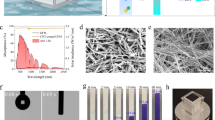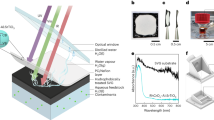Abstract
The utilization of solar energy for electricity and water generation is widely considered as a sustainable solution for water scarcity and electricity shortages. Here we present a rationally designed hybrid system based on the passive interfacial cooling (PIC) strategy. The PIC region within the system intensifies energy exchange between the power generation and water generation modules, thereby boosting the utilization of waste heat and latent heat from the hybrid modules and minimizing the energy loss to air. As a result, the PIC-induced cogenerator exhibited a superior power density of 1.5 W m−2 and an outstanding water evaporation rate of 2.81 kg m−2 h−1 under 1 Sun illumination, which were 328% and 158% higher than those of devices without the PIC effect. The system also exhibited excellent salt rejection ability, stability, durability and applicability under various harsh conditions, demonstrating its potential for practical applications. The effectiveness of the PIC strategy in enhancing photovoltaic-based power generation systems has also been established, resulting in an increase in power density from 55.7 W m−2 to 75 W m−2. This study provides insights into the design of power–water cogenerators and advances their application with multiple natural energy sources for high-efficiency power–water cogeneration.
This is a preview of subscription content, access via your institution
Access options
Subscribe to this journal
Receive 12 digital issues and online access to articles
$99.00 per year
only $8.25 per issue
Buy this article
- Purchase on Springer Link
- Instant access to full article PDF
Prices may be subject to local taxes which are calculated during checkout





Similar content being viewed by others
Data availability
All relevant data that support the findings of this study are presented in the Article and Supplementary Information. Source data are provided with this paper.
References
World Water Development Report 2018 (UN-Water, 2018); https://www.unwater.org/publications/world-water-development-report-2018
Boretti, A. & Rosa, L. Reassessing the projections of the World Water Development Report. npj Clean Water 2, 15 (2019).
Wang, W. et al. Integrated solar-driven PV cooling and seawater desalination with zero liquid discharge. Joule 5, 1873–1887 (2021).
Chen, C., Kuang, Y. & Hu, L. Challenges and opportunities for solar evaporation. Joule 3, 683–718 (2019).
Ding, T. & Ho, G. W. Using the sun to co-generate electricity and freshwater. Joule 5, 1639–1641 (2021).
Xue, G. et al. Water-evaporation-induced electricity with nanostructured carbon materials. Nat. Nanotechnol. 12, 317–321 (2017).
Yang, P. et al. Solar-driven simultaneous steam production and electricity generation from salinity. Energy Environ. Sci. 10, 1923–1927 (2017).
Ding, T. et al. All-printed porous carbon film for electricity generation from evaporation-driven water flow. Adv. Funct. Mater. 27, 1700551 (2017).
Tan, J. et al. Self-sustained electricity generator driven by the compatible integration of ambient moisture adsorption and evaporation. Nat. Commun. 13, 3643 (2022).
Dao, V.-D., Vu, N. H., Thi Dang, H.-L. & Yun, S. Recent advances and challenges for water evaporation-induced electricity toward applications. Nano Energy 85, 105979 (2021).
Meng, F. L. et al. Modular deformable steam electricity cogeneration system with photothermal, water, and electrochemical tunable multilayers. Adv. Funct. Mater. 30, 2002867 (2020).
Li, Z. et al. Polyaniline‐coated MOFs nanorod arrays for efficient evaporation‐driven electricity generation and solar steam desalination. Adv. Sci. 8, 2004552 (2021).
Li, X., Xie, W. & Zhu, J. Interfacial solar steam/vapor generation for heating and cooling. Adv. Sci. 9, 2104181 (2022).
Xu, N. et al. Synergistic tandem solar electricity-water generators. Joule 4, 347–358 (2020).
Li, T. et al. Simultaneous atmospheric water production and 24-hour power generation enabled by moisture-induced energy harvesting. Nat. Commun. 13, 6771 (2022).
Zhu, L., Ding, T., Gao, M., Peh, C. K. N. & Ho, G. W. Shape conformal and thermal insulative organic solar absorber sponge for photothermal water evaporation and thermoelectric power generation. Adv. Energy Mater. 9, 1900250 (2019).
Xu, Y. et al. Harvesting solar energy by flowerlike carbon cloth nanocomposites for simultaneous generation of clean water and electricity. ACS Appl. Mater. Interf. 13, 27129–27139 (2021).
Zhang, Y., Ravi, S. K. & Tan, S. C. Food-derived carbonaceous materials for solar desalination and thermo-electric power generation. Nano Energy 65, 104006 (2019).
Chen, L., Ren, J., Gong, J., Qu, J. & Niu, R. Cost-effective, scalable fabrication of self-floating xerogel foam for simultaneous photothermal water evaporation and thermoelectric power generation. Chem. Eng. J. 454, 140383 (2023).
Mu, X. et al. A robust starch–polyacrylamide hydrogel with scavenging energy harvesting capacity for efficient solar thermoelectricity–freshwater cogeneration. Energy Environ. Sci. 15, 3388–3399 (2022).
Wang, F. et al. A high-performing single-stage invert-structured solar water purifier through enhanced absorption and condensation. Joule 5, 1602–1612 (2021).
Shi, Y., Ilic, O., Atwater, H. A. & Greer, J. R. All-day fresh water harvesting by microstructured hydrogel membranes. Nat. Commun. 12, 2797 (2021).
Ni, G. et al. A salt-rejecting floating solar still for low-cost desalination. Energy Environ. Sci. 11, 1510–1519 (2018).
Zhou, X., Zhao, F., Guo, Y., Rosenberger, B. & Yu, G. Architecting highly hydratable polymer networks to tune the water state for solar water purification. Sci. Adv. 5, eaaw5484 (2019).
Sun, Z. et al. Achieving efficient power generation by designing bioinspired and multi-layered interfacial evaporator. Nat. Commun. 13, 5077 (2022).
Wu, X. et al. A photothermal reservoir for highly efficient solar steam generation without bulk water. Sci. Bull. 64, 1625–1633 (2019).
Xu, J. et al. Ultrahigh solar-driven atmospheric water production enabled by scalable rapid-cycling water harvester with vertically aligned nanocomposite sorbent. Energy Environ. Sci. https://doi.org/10.1039/D1EE01723C (2021).
Cui, Y. et al. Smart sponge for fast liquid absorption and thermal responsive self‐squeezing. Adv. Mater. 32, 1908249 (2020).
Li, R., Shi, Y., Wu, M., Hong, S. & Wang, P. Photovoltaic panel cooling by atmospheric water sorption–evaporation cycle. Nat. Sustain. 3, 636–643 (2020).
Li, X. et al. Enhancement of interfacial solar vapor generation by environmental energy. Joule 2, 1331–1338 (2018).
Song, H. et al. Cold vapor generation beyond the input solar energy limit. Adv. Sci. 5, 1800222 (2018).
Lin, Z. et al. Poly(N-phenylglycine)/MoS2 nanohybrid with synergistic solar-thermal conversion for efficient water purification and thermoelectric power generation. ACS Appl. Mater. Interf. 14, 1034–1044 (2022).
Ren, J., Ding, Y., Gong, J., Qu, J. & Niu, R. Simultaneous solar‐driven steam and electricity generation by cost-effective, easy scale-up MnO2-based flexible membranes. Energy Environ. Mater. 6, 1–9 (2023).
Li, X. et al. Exhausted Cr(VI) sensing/removal aerogels are recycled for water purification and solar‐thermal energy generation. Small 18, e2201949 (2022).
Jiang, H., Ai, L., Chen, M. & Jiang, J. Broadband nickel sulfide/nickel foam-based solar evaporator for highly efficient water purification and electricity generation. ACS Sustain. Chem. Eng. 8, 10833–10841 (2020).
Wani, T. A., Garg, P., Kaith, P. & Bera, A. Freshwater–electricity co-generation in solar-driven water desalination: an effective approach toward the water–energy nexus. J. Mater. Chem. A 10, 21273–21278 (2022).
Cooper, T. A. et al. Contactless steam generation and superheating under one sun illumination. Nat. Commun. 9, 5086 (2018).
He, S. et al. Nature-inspired salt resistant bimodal porous solar evaporator for efficient and stable water desalination. Energy Environ. Sci. 12, 1558–1567 (2019).
Zhang, L. et al. Highly efficient and salt rejecting solar evaporation via a wick-free confined water layer. Nat. Commun. 13, 849 (2022).
Heat Transfer Module User’s Guide, Version 5.6. https://doc.comsol.com/5.6/doc/com.comsol.help.heat/HeatTransferModuleUsersGuide.pdf (2020).
Acknowledgements
We gratefully acknowledge the financial support provided by the Shenzhen-Hong Kong Science and Technology Innovation Cooperation Zone Shenzhen Park Project (grant no. HZQB-KCZYB-2020030), the Hong Kong Innovation and Technology Commission via the Hong Kong Branch of National Precious Metals Material Engineering Research Centre, the Research Grants Council of Hong Kong (project no. AoE/M-402/20) and the Start-up Fund (UGC) for Research Assistant Professors under the Strategic Hiring Scheme of The Hong Kong Polytechnic University (grant no. 1-BDS2).
Author information
Authors and Affiliations
Contributions
Z.M., Q.W. and J.L. developed the concept. Z.M., Y.Y., J.S., J.L. and Q.W. conducted the experiment, characterization and performance test. Yuhan Chen, Yingxian Chen and B.Z. provided constructive suggestions for the results. Z.M., Q.W. and J.L. wrote manuscript. All co-authors discussed the results.
Corresponding authors
Ethics declarations
Competing interests
The authors declare no competing interests.
Peer review
Peer review information
Nature Water thanks Xinsheng Peng and the other, anonymous, reviewer(s) for their contribution to the peer review of this work.
Additional information
Publisher’s note Springer Nature remains neutral with regard to jurisdictional claims in published maps and institutional affiliations.
Supplementary information
Supplementary Information
Supplementary Notes 1–3, Figs. 1–31, Tables 1–4 and References.
Supplementary Video 1
Fast water absorption of the trident-shaped evaporator.
Supplementary Video 2
Compression of the trident-shaped evaporator.
Supplementary Video 3
Charging a smartwatch.
Source data
Source Data Figs. 2–5
Statistical source data.
Rights and permissions
Springer Nature or its licensor (e.g. a society or other partner) holds exclusive rights to this article under a publishing agreement with the author(s) or other rightsholder(s); author self-archiving of the accepted manuscript version of this article is solely governed by the terms of such publishing agreement and applicable law.
About this article
Cite this article
Mao, Z., Yao, Y., Shen, J. et al. Passive interfacial cooling-induced sustainable electricity–water cogeneration. Nat Water 2, 93–100 (2024). https://doi.org/10.1038/s44221-023-00190-6
Received:
Accepted:
Published:
Issue Date:
DOI: https://doi.org/10.1038/s44221-023-00190-6



